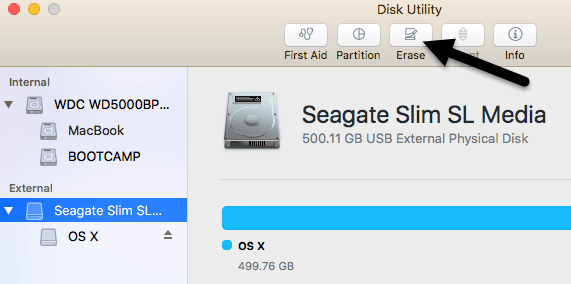Format Flash Drive Mac Os Extended Journaled In Windows
Solution
A quick video on how you can convert your HDD partition from the NTFS format to the HFS+ Format that is supported by Macintosh & Hackintosh PC'sConvert Dynam. I have booted Ubuntu 14.04 through a live cd. How do i format a usb to Mac OS X Extended (Journaled). Right now in GParted there isnt even an option to format the usb. I am not sure how to go about doing this. To format a hard drive in Windows, you'll use the Disk. How to format a hard drive on a Mac. And choose 'Mac OS Extended (Journaled)' as the operating system. I’ve ordered a usb to sata cable to format the drive from another mac, but can i format the drive (as OS X extended journaled) in windows? Tl:dr - How do i format a clean ssd as OS X extended journaled, as opposed to exFAT etc., from a pc? Now, click on the top partition, name it 'Windows,' and change its format to MS-DOS. Then click the second partition, name it 'Mac,' and change its format to Mac OS Extended (Journaled).

Most External drives come preformatted with the Master Boot Record (MBR) partition scheme. If you are formatting your external drive to use as a recovery drive you will need to format to Mac OS X Extended (Journaled)
- Navigate to the Utilities folder by using the shortcut Command-Shift-U in the finder or type in “Disk Utility” via Spotlight.
- Plug your external drive into your Mac (you will then see it appear in both disk utility and your desktop)
- Select the external disc (do not select the volume entry which is below)
- Click the Erase tab
- In the format table please select Mac OS X Extended (Journaled) in the list of options
- Click on Erase and confirm that you wish to do this.
- Once the disk has successfully formatted it should know in the Partition Map Scheme that it is GUID Partition Table.
- To remove the disk click on the eject button and remove once it has fully ejected.

Disk Utility
Disk Utility is a disk utility on macOS operating system. It supports creating, splitting, merging, resizing, deleting and formatting partitions on the hard disk. Disk Utility only supports partition creation and formatting for Mac OS Extended (Journaled), exFAT, MS-DOS (FAT) and since MacOS High Sierra (10.13), it supports APFS.
If you are a Linux user or operating systems other than macOS, you probably use another tool. In another case, if you are using a Seagate, WD My Passport or any other hard drive that you previously partitioned with another tool. Disk Utility will report MediaKit reports not enough space on device for requested operation. This error occurs because the partitions created do not comply with Apple’s partition policy. In this case, you can use other tools instead of Disk Utility.
In this article, I will guide you to create a Mac OS Extended (Journaled) partition with GParted. If you want to install macOS High Sierra or later versions, just use the Convert to APFS feature on Disk Utility.
GParted
GParted is a well known disk partitioning program. It supports many partition formats such as FAT32, NTFS, exFAT, Ext4 and of course supports Mac OS Extended. We can use GParted to create Mac OS Extended partitions in just a few simple steps.
GParted comes pre-installed on many Linux distributions like Ubuntu, Debian, Linux Mint… If you already have GParted installed, just use it. If not, you can download GParted or 4MParted ISO files then integrate into AIO Boot. You should use these two operating systems, as they have pre-installed programs that support the format. If you use GParted on Ubuntu, Linux Mint or Debian, you need to install hfsprogs.
The format of Mac OS Extended is HFS+. There are some commercial softwares that support creating HFS + partitions on Windows, but GParted is free. Now we will create the HFS+ partition with GParted.
- Run GParted and select the hard disk in the dropdown list at the top right. My hard disk is /dev/sda.
- You can only create new partitions if your hard disk has unallocated space. Right-click on the unallocated space and select New. You can also format existing partitions to HFS+. Right-click the existing partition, select Format to, and then select hfs+. Or delete the existing partition to recreate it.
- Select hfs+ in the File system. Then select and enter some information for the other items you want.
- Click Add, then click Apply to apply the changes.
The Mac OS Extended partition created by GParted will not be journaled. However, we can use Disk Utility to Enable Journaling. Or use the following command to format Mac OS Extended to Mac OS Extended (Journaled):


/dev/sdaX is the partition you want to format.
Convert to APFS
From the MacOS High Sierra version, Apple announced a new file system called APFS. By default, macOS High Sierra can only be installed on an APFS partition. You can use Disk Utility to convert Mac OS Extended partitions to APFS without losing data.
If the Mac OS Extended partition is not Journaled, please journaled it first. Run Disk Utility, select the Mac OS Extended partition in the left column, then select File and select Enable Journaling.
Using Flash Drive On Mac
Now you can convert Mac OS Extended (Journaled) partitions to APFS without losing data. Just select Edit and select Convert to APFS…
Format Flash Drive Mac Os Extended Journaled In Windows 8
By using GParted with the simple steps above, we can easily create Mac OS Extended (Journaled) partitions and many other formats that Disk Utility does not support. If you need to create macOS High Sierra bootable USB from Windows, you can try Clover Boot Disk. Good luck!